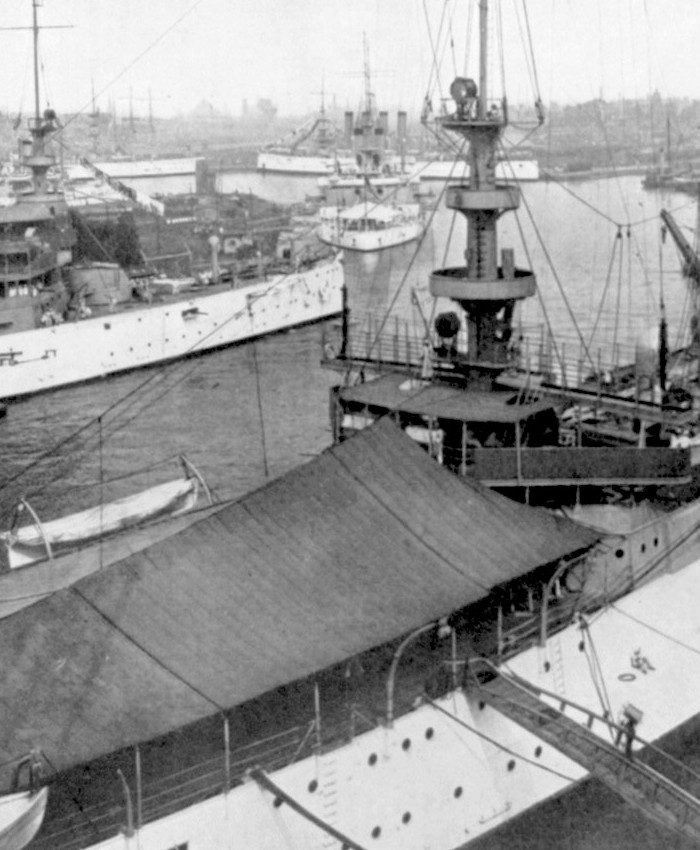CUS Boston (AC-1908 (TS-1922))
Back to Commonwealth Union of America ship list:
This class and the following Albany class were the cruiser equivalents to the Connecticut and Mississippi class. In following those battleship classes layout but keeping the armament in a homogenous group, the CUA navy had produced the first all big gun cruiser but because of the length of their building times the British had built and completed both Dreadnought and Invincible before the CUA completed any of these ships or the Michigan class battleships.
The Connecticuts with their mixed armament of 12" and 8" guns were classed as semi-dreadnoughts, the Bostons which replaced the 12" with another pair of 8" were still classed as armoured cruisers through till 1912-13 when the term 'battlecruiser' came into fashionable use. The Boston class were excellent ships for their time. They were immediately outclassed by a lot of other nations dreadnought cruisers. They were built to be used as 'scout' ships and had the problem that turbines and the speed of the Dreadnought type battleships increased to the 20-22 knot range the Bostons at 23-24 knots (on a good day) were no longer fast enough to carry out that duty. This is where the CUA's failure to build dreadnought cruisers from 1910-20 hampered their battlefleets use as they had no 'cruiser' type vessels that could act as 'eyes of the fleet'. Despite their shortcomings the Bostons and Albanys provided sterling service as vanguard of the fleet during WW1.
At the end of WW1 the four Boston class were used to help repatriate the CUA Army personnel to their homelands. With the start of the Geneva Arms Limitation talks in 1920 it was positive that these 14,000 ton armoured cruisers would be outside the new limits and would need to be reduced to anciliary duties. One thing a large Navy needs is a number of dedictaed Training vessels. With the laying down of the Detroit class scout cruisers, to be armed with reconditioned twin 8", the Boston class was withdrawn from frontline service to be converted for their new duties. This entailed removing the four twin 8" wing turrets (one new main armament for a Detroit class ship), the deletion of enough boilers to reduce the speed to 15 knots with the appropriate power output. The two fore funnels were trunked together and capped, while various bits of armament were added and subtracted as required. The four ships were used in pairs on the east and west coasts. The west coast pair operated between Seattle and Honolulu, while the Eastern pair operated between Newfoundland and New York, with side trips to the UK and Ireland.
The ships continued with their training duties even with the outbreak of war. The two East coast ships now did convoy duty up and down the East coast and accross to the UK when their presence was deemed appropriate. The West coast ships were used to escort ships to Honolulu and down the western seaboard to the Canals.
| Displacement | 11,800 tons std 14,400 tons full load | |
| Length | 503 ft | |
| Breadth | 73 ft | |
| Draught | 26 ft | |
| Machinery | 2 shaft triple expansion 10,000shp | |
| Speed | 15 knots | |
| Range | 6,000 miles at 10 knots (3,000 nm at 15 knots) | |
| Armour | 7" side armour, 2" deck armour, 7" turrets. | |
| Armament | As Armoured Cruiser 12 x 8" (6x2) 8 x 4" (8x1) 4 x 3" AA (4x1 - 1917)
|
As Training Ship 4 x 8" (2x2) 8 x 4.5" (4x2) 4 x 4" (4x1) 18 x 40mm (4x4 1x2) 16 x 20mm (16x1) |
| Aircraft | nil | |
| Torpedoes | nil | |
| Complement | 715 | |
| Notes | CUS Boston | |
